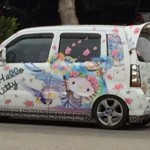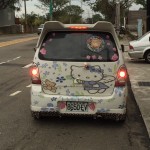itasha痛車
(痛車是指在車身外觀將動漫遊戲或是動漫畫人物的圖案以彩繪或貼紙黏貼等方式裝飾上去的車輛,發源於日本)
Though the first attempts at itasha began as early as the 1980s in Japan, this style of decorating cars with brightly-colored cartoon or anime characters did not take off internationally until the early 21st century on Internet sites. Other products, such as computer covers and even airplanes, were also used to showcase itasha, as this art form is now known. The word itasha seems to be derived from a combination of the Japanese words for itai (painful) and sha (vehicle). The former word here means painful, which can be interpreted as “painful for the wallet” due to the high costs involved.
rosemaling 樂斯梅林
(亦稱裝飾彩繪丶玫瑰彩繪或花卉彩繪等,是一種發源自挪威鄉村地區的傳統民俗藝術,以其鮮明色彩丶漩渦型紋路和花卉裝飾圖案為特徴,在實際生活中應用於各類器具丶服裝丶建築 外觀或室內裝潢的美化)
Rosemaling is a Norwegian word referring to the exquisitely painted drawings on wood surfaces such as plates, furniture, or handicrafts. As early as the mid-18th century, rural villagers apparently killed time during the long, cold winters of Scandinavia by decorating their mostly wooden belongings. The inspiration for this vivid, colorful style most likely came from the flourishing of Baroque and Rococo art that was popular in Europe at that time and earlier. Rosemaling’s basic theme revolves around flowers, but not necessarily roses. Perhaps the lack of vegetation during the severe Norwegian winters inspired villagers and farmers to feel nostalgic about the flowers of spring and summer. On the other hand, floral decorations were also popular in Baroque and Rococo paintings.
anime 動畫片
(尤指日本製作的動畫,為animation的縮寫,因 anime在英文中使用也相當廣泛,已經成為一個新 的英文單字。相較於針對兒童製作的卡通影片( cartoon ) , anime不管是在情節架構丶人物刻畫和技術運用上都更加深入和複雜,喜歡動畫的觀眾也不侷限於兒童)


